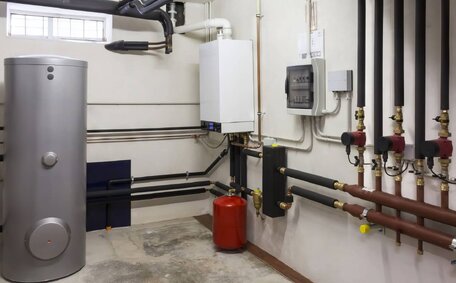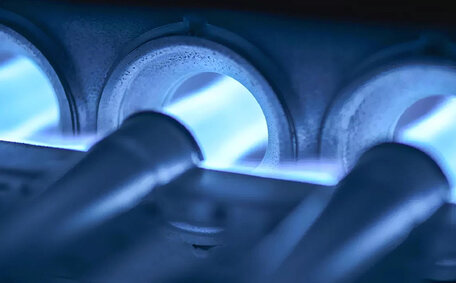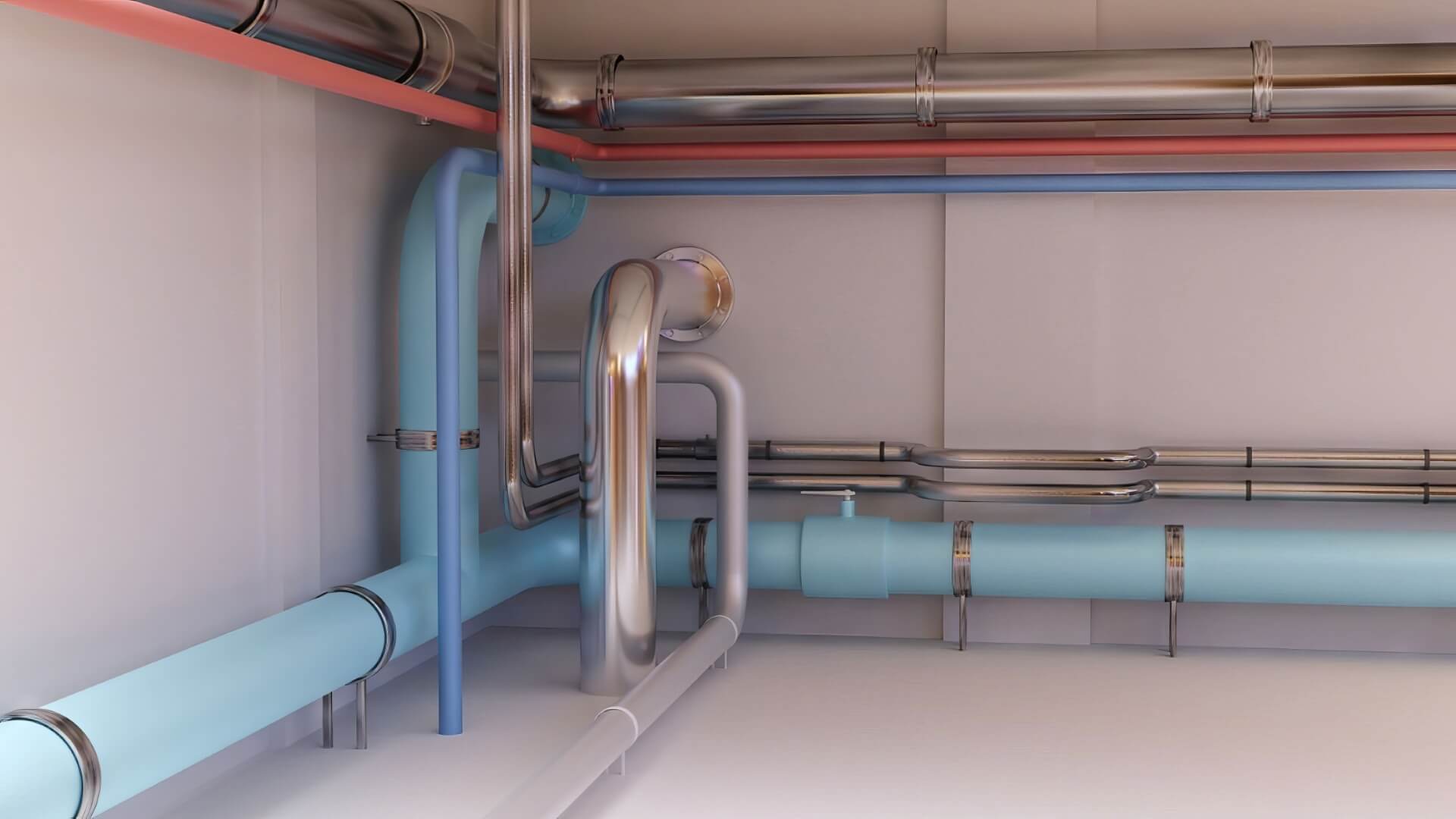Locating Your Gas Meter Outside
It’s vital to know how to shut off your gas supply from the meter for safety and easy access. Inspect the perimeter of your property to locate the gas line and metre box. It may be around a corner or on the side your gas pipes enter the building.
Gas metres are typically enclosed in a grey meter box mounted on the exterior wall of your home, usually near the front. If access is blocked, remove overgrowth or debris carefully, avoiding damage to internal components. Consult your property blueprint for the meter location if it’s not immediately visible.
During inspection, ensure the box is intact, undamaged, and securely mounted, reporting any concerns promptly to your gas company.
Identifying the Gas Supply Line
The gas lines between the meter and your home are typically yellow pipes about 1 to 2 inches in diameter. This main line routes from the ground to your home, connecting to the gas meter on the exterior. Inside, look behind the gas stove and near the floor or basement ceiling for supply lines running to items like your water heater, or dryer.
Gas lines can be steel, copper, plastic, or other suitable materials. Gas shutoff Valves along the way, designed to control the flow gas, allow you to shut off the supply. Any accessible gas pipe in your system that you can turn off should have labels or colour coding indicating their purpose.
Being able to identify your gas shutoff valve along the supply line helps you understand how shut off your gas at various points if needed. Begin at the meter, using the external valve to cease all gas flow into your home.
Knowing your gas supply line’s route and valve locations enables quick emergency response and professional assistance.
Finding the Manual Gas Cutoff Valve
The meter valve typically enables manual shutdown of your home’s entire gas supply. This crucial valve is typically situated near the gas meter, either on the piping or within the meter box. The valve will be connected to the main supply pipe bringing gas into your home.
It may have the word "valve" stamped on it. When the valve handle aligns with the pipe, gas can flow. This 'need turn off’ stops all supply gas from entering your home’s gas appliance supply lines.
To restore gas flow, realign the valve with the pipe after completing maintenance. Outside, find your gas meter, then locate a valve resembling a spigot or tap handle.
Turn tap on the manual cutoff only during true emergencies or when shutting off gas for maintenance when a professional has deemed it necessary. It’s critical to never attempt to turn off gas supply when working gas appliances in your home without the know-how for safe turn protocols.
Safely Turning Off Gas Appliances
Before shutting off the gas, ensure you can turn off each appliance separately. This strategy safeguards how to turn off appliances in your home and prevents unused gas from accumulating within dormant devices, averting potential hazards.
Turn off each appliance’s valve, halting gas flow to the equipment. Be prepared to turn off gas-fed systems such as water heaters, dryers, stoves, and heaters.
Each unit’s shutoff valve will be situated either behind it or nearby.
Check if your appliances have pilot lights. Gently turn control knobs to the 'off’ position to fully extinguish lit pilot flames. You’ll need to know how to shut down any pilot flames to make sure none are left burning when gas flow is disrupted.
With all shutoff valves secured and pilot lights extinguished, you may safely proceed to shut off gas at the manual cutoff valve located outside near your gas meter gas. Post-shutoff, engage gas professionals to safely reignite pilots and turn appliance valves back on.
Step-by-Step Process to Turn Off Gas Supply
Follow these key steps to safely disconnect gas and shut off your gas supply:
- Locate your gas metre outside and identify the main shutoff valve attached to your home’s gas water system supply line.
- Go inside and turn off all individual gas appliances like water heaters, stoves, etc. You’ll need to turn off valve knobs to the "off" position and ensure all pilot lights are out.
- Return to the manual shutoff valve on the gas supply line outside.
- To turn off gas, twist the handle a quarter rotation into the off position perpendicular to the pipe until it halts.
- Call your gas provider or a licensed gas fitter. Let them conduct safety checks before restoring flow.
- When it has been deemed safe to turn back on, gently rotate the manual shutoff valve handle to help restore alignment with the pipe.
- Carefully return inside, relight pilot lights and turn appliance valves to "on" to resume gas flow.
Consult professionals if you have any concerns about safely switch off or restoring gas service. Attempting to tamper with equipment without training risks serious hazards.
Checking for Leaks and Calling a Professional
Post-shutoff, vigilantly check for gas odours as they may signal a leak. If you detect a rotten egg smell or hear a hissing noise, evacuate the property straight away and call the fire brigade on 000. Avoid trying to pinpoint the leak personally.
If gas appliances won’t ignite or pilots extinguish frequently, refrain from DIY repairs; immediately call a licensed plumber or gas fitter. Seek immediate assistance if issues arise when trying to turn the gas supply off after maintenance.
Qualified technicians have specialised leak detection equipment to pinpoint the exact location of gas escapes.Never try DIY fixes on gas systems beyond basic shutoffs with the main valve. Always involve authorities if you suspect any type of gas leak or appliance malfunction after shutting off or restoring your home’s supply.
The consequences of tampering without training could prove disastrous.
Turning the Gas Supply Back On
After professionals have addressed any gas concerns, you can securely turn your gas supply back on. Follow these steps:
- Confirm all gas appliances are switched off and pilot lights are extinguished.
- Go to the manual shutoff valve on the main gas supply line outside.
- Gradually turn the appliance taps valve counterclockwise until the handle aligns with the pipe and ceases movement.
- Check all connections for gas leaks by spraying with a soap solution, then proceed to relight your pilot lights if there are no signs of escaping gas. Bubbles indicate escaping gas.
- If no leaks appear, proceed inside to relight pilot lights and turn appliance valves to "on" positions.
- Carefully reignite all pilots while checking burner operation. Adjust as needed.
If pilots fail to stay lit, smells persist or you have other issues you don’t want to ignore, call a professional immediately. Never leave gas appliances inoperable after restoring supply.
Maintaining Accessibility to the Shutoff Valve
It is crucial to keep the path to your gas metre’s manual shutoff valve free of obstructions. Overgrown vegetation, stored items, vehicles, or debris can prevent quick access in an emergency. Regularly inspect the valve area for clear access.
Prune any greenery intruding on the area surrounding your home’s meter box, ensuring unimpeded valve access.
Avoid placing ladders, bins, bicycles or furniture around the valve area as well. Keep a minimum of 3 feet (1 metre) clearance so you and technicians can easily reach the valve.
Do not erect fences or buildings that impede direct access to the valve box. Having multiple barriers slowing response times during a dangerous gas leak threatens safety. Report obstructions that are out of your control to your local gas networks or utilities provider.
By maintaining accessible shutoff valve placement, you empower yourself to act swiftly in the event of a gas emergency. Quick shutoffs can prevent fires, explosions and other catastrophic damage when seconds matter most.
Understanding Homeowner vs. Provider Responsibilities
Both homeowners and gas service providers have crucial roles to play in ensuring gas safety. However, only licenced technicians should conduct leak checks, restore disconnected service, or relight pilots. You are also responsible for maintaining clearance around the valve, keeping appliance connectors/piping intact, and arranging inspections/repairs.
As a homeowner, you must know how to locate your gas metre, identify the supply line, and safely operate the manual shutoff valve in emergencies.
Evacuate immediately if you smell gas or suspect a leak and call emergency services – do not attempt to fix the issue yourself; professional help is required.
During outages or planned work, rely on certified personnel to conduct proper safety reviews before reinitiating supply. While you manage routine access considerations, providers uniquely carry out tasks in detecting dangers, enacting shutdown protocols, and correcting problems discovered.
Learn to operate your shutoff valve in emergencies, relying on providers for complex diagnostics and restorations.
Clarify specific homeowner vs. company duties in your service agreement. Mutual vigilance from both parties ensures a safe and reliable gas system.
Emergency Contact Information
In a gas-related emergency, having the contact details for a qualified professional plumber or gas fitter is essential. Contact us at Bossley Park Plumbing on 1300 349 338 for emergencies; our licensed experts are ready 24/7 to address leak, appliance or supply issues.
In the event of gas odour, hissing sounds from pipes, or persistent pilot light issues, evacuate everyone and call 000 without delay. Do not try to find or stop the leak yourself. Our first responders can quickly assess hazards and shut off supply when lives may be at risk.
For non-urgent matters, contact us at jobs@bossleyparkplumbingservices.com.au or on 1300 349 338 to arrange for certified gas fitters to carry out the necessary work. We also offer supply restoration, leak detection, piping repairs, and pilot relighting services after outages.
Knowing whom to contact allows for prompt, correct responses in gas emergencies. At Bossley Park Plumbing, safety through competent, ethical service is our top priority. Keep our details handy and don’t hesitate to call us 24/7.






